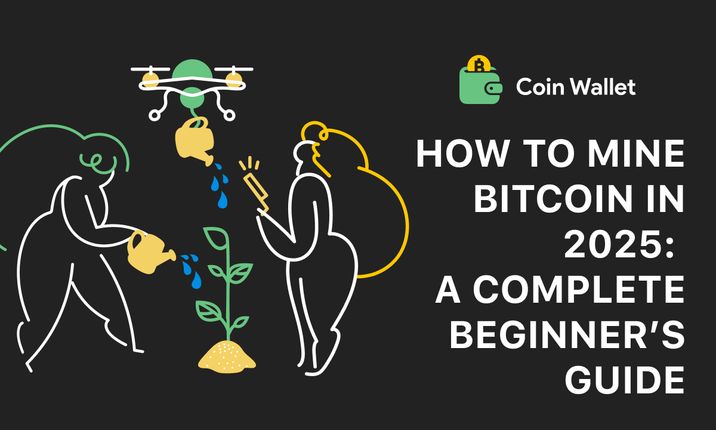How to Mine Bitcoin in 2025: A Complete Beginner’s Guide

How to Mine Bitcoin in 2025: A Complete Beginner’s Guide
Bitcoin mining is one of the early foundations of the crypto industry. We have all heard tales of fortunes made and lost on BTC mining, like the one about lost treasure in a Welsh landfill, but are these stories possible today?
The core principles of Bitcoin mining haven’t changed since Satoshi Nakamoto designed them. Some important parameters have, though. Technological improvement in mining rigs, increased mining difficulties, and growing energy concerns all play a major role in determining whether mining is still a viable option in 2025.
Hopefully, after reading this guide, you will know whether it is an option for you.
What Is Bitcoin Mining?
At a basic level, Bitcoin is a process where new blocks are added to the Bitcoin blockchain. In essence, a miner solves a series of complicated mathematical puzzles through a process known as Proof of Work (PoW), and for each completed one receives a reward in the form of BTC coins.
The process provides incentives for miners and also ensures that the Bitcoin ledger remains tamper-proof by preventing any single person from altering it.
The Evolution of Bitcoin Mining
Bitcoin mining has changed dramatically since its start in 2009. At first, people used their PCs to mine BTC, but as the difficulty increased, a vast majority of ordinary PCs just couldn’t cope with it. The next step was more powerful CPUs and GPUs until we reached the stage where specialized mining rigs specifically designed for the task, called ASIC miners, started dominating the scene.
Mining difficulty mainly increases through halving, an event that reduces the amount of BTC a miner receives as a reward per block. The halving occurs every four years and it is a built-in deflationary mechanism aiming at stabilizing the supply and demand of Bitcoin.
The latest halving event in 2024 reduced the reward to just 3.126 BTC per block, forcing mining companies to either invest in more rigs or increase the efficiency of the ones they have. For comparison’s sake, when the Bitcoin network first launched, miners earned 50 BTC per block.
Choosing the Right Hardware
Running a successful Bitcoin mining operation in 2025 requires highly specialized mining rigs. The current industry standard is Application-Specific Integrated Circuit (ASIC) miner. There are plenty of models available on the market, but the best-performing ones are the Bitmain Antminer S21 Pro, the Whatsminer M70, and the Avalon 1600 series. Delivering upwards of 200 terahashes per second (TH/s), these machines are the pinnacle of Bitcoin mining, but they do cost a pretty penny. Although miners are a core of every Bitcoin mining operation, you will also need other equipment. A reliable power supply is a must, as well as ventilation, depending on your occasion. These rigs throw off a lot of heat and keeping them cool and preventing them from burning out is a major task.
Selecting Mining Software
Managing your newly established mining operation will require some serious software. There are many crypto mining apps on the market, so you will need to do some research before deciding which one is the best fit for you. There are several factors that you need to consider when making the decision, like your hardware, the level of your technical expertise, and any specific demands your operation may have. Once you have clear parameters, choosing the correct mining software will be much easier.
Should You Join a Mining Pool?
Mining pools offer a far more profitable mining experience than going at it solo. Due to increased competition, solo miners can easily strike out and fail to secure the reward. Mining pools, on the other hand, can secure a consistent payday for their users.
Some of the best choices include F2Pool, Foundry USA, ViaBTC, and Binance Pool, all widely used and with strong reputations. The only downside of joining one is that they charge a small percentage of your total earnings, but we feel that the benefits they offer far outweigh the cost.
Challenges in 2025
The two biggest challenges for Bitcoin mining in 2025 are hardware costs and availability. These major hurdles can prevent many people from starting a mining career. Established miners also face some difficulties, mainly the need to replace their mining rigs every several years as they quickly become obsolete. Depending on the location, heat, noise, and energy consumption can also be severe obstacles. Finally, the volatility of Bitcoin price is always a concern, requiring miners to plan when to sell their BTC hoard. If the timing isn’t right, they could easily end up in the red.
Conclusion
Despite all these problems, Bitcoin can be a steady source of income for people who are well-acquainted with the process and can afford significant upfront costs. But if you are planning a small operation, running a few rigs in a corner of your room, you might as well give up right away and save yourself a lot of headaches. The days of such hobby setups are long gone, and the only way to make some money in mining is to plan almost an industrial-size operation.